Educational Session Goals
- Reduce the number of smokers in Mississippi.
- Educate Mississippi citizens about the dangers of smoking to prevent young people from being attracted to it.
- Develop a strategy that will be combating tobacco manufacturers.
The main strategies of the training session are to reduce the number of smokers in Mississippi, conduct a training program on the dangers of smoking and work with tobacco producers.
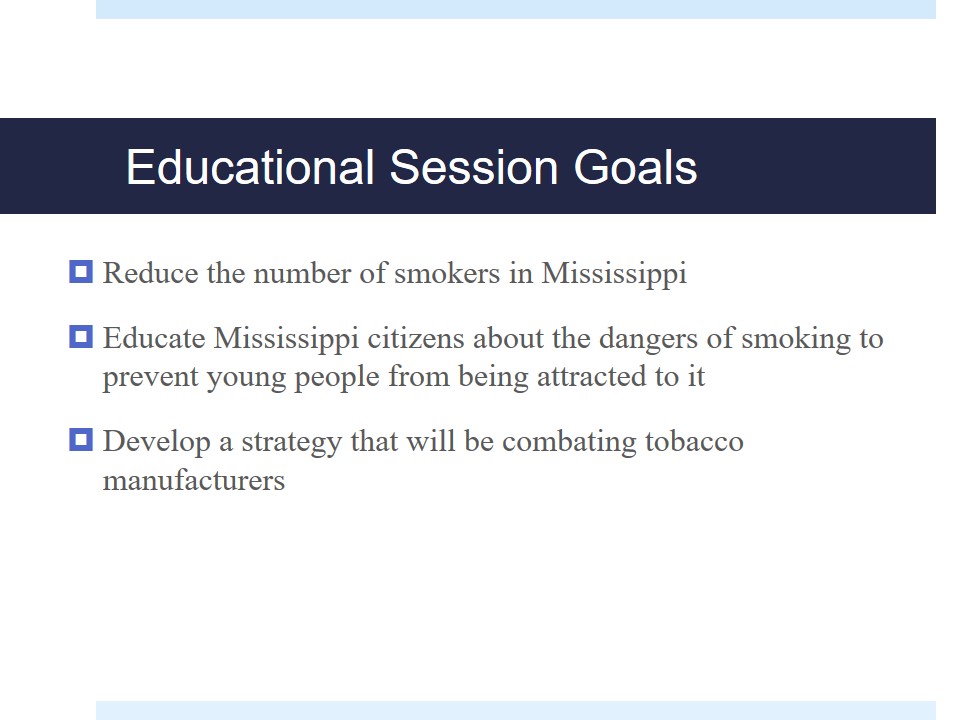
Overview of the Issue
- The tobacco epidemic is one of the most severe threats to public health that has ever occurred globally. All forms of tobacco use are harmful to health, and there is no harmless dose of tobacco.
- Tobacco is consumed for the effects of its main active ingredient: nicotine. Nicotine is highly addictive when it enters the lungs.
- Tobacco combustion products contain other substances that can cause a significant increase in morbidity and mortality.
The most common form of tobacco use in the world is cigarette smoking. Other types of tobacco products include hookah tobacco, cigars, cigarillos, and self-rolled tobacco. Tobacco, in most cases, is smoked primarily in the form of cigarettes. Smoking is the most harmful form of tobacco use. However, all tobacco products contain carcinogens and other toxins; even smokeless tobacco products are not a safe alternative to smoking (American Cancer Society 2020).
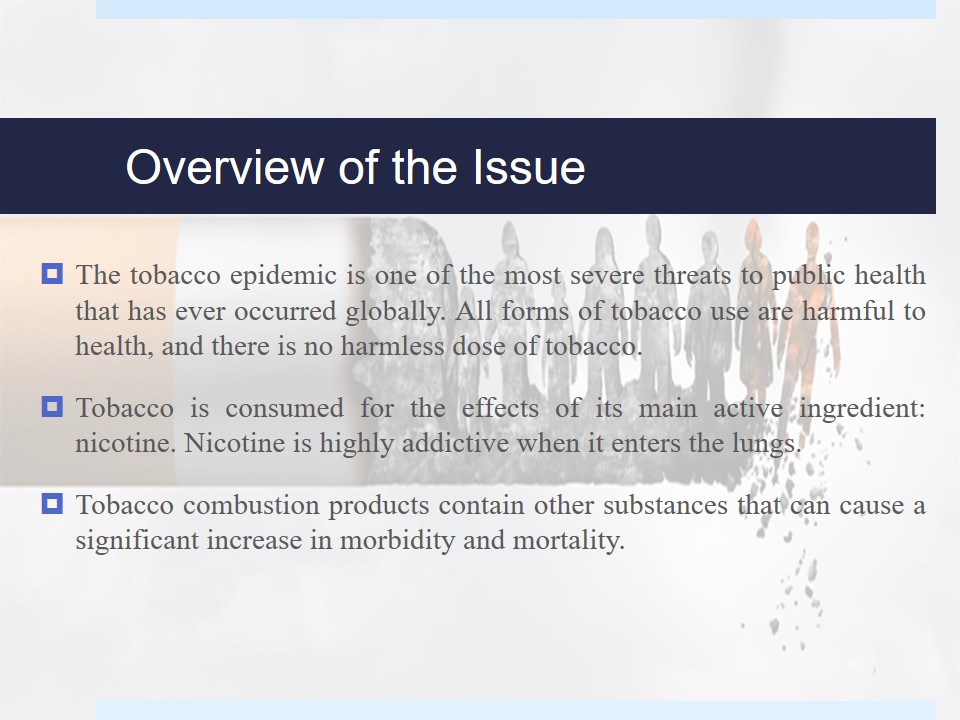
Types of Tobacco Products
- A cigarette is a smoking tobacco product consisting of cut raw materials wrapped in cigarette paper;
- Hookah tobacco is a mixture of cut raw materials with or without non-tobacco raw materials and other ingredients;
- Thin-cut smoking tobacco consisting of cut, torn, twisted, or compressed tobacco with or without the addition of non-tobacco raw materials and flavorings;
- Non-smoking tobacco products – tobacco products intended for chewing or sniffing.
Tobacco products are products made entirely or partially from tobacco leaf as raw material, prepared in such a way as to be used for smoking, chewing, or sniffing.
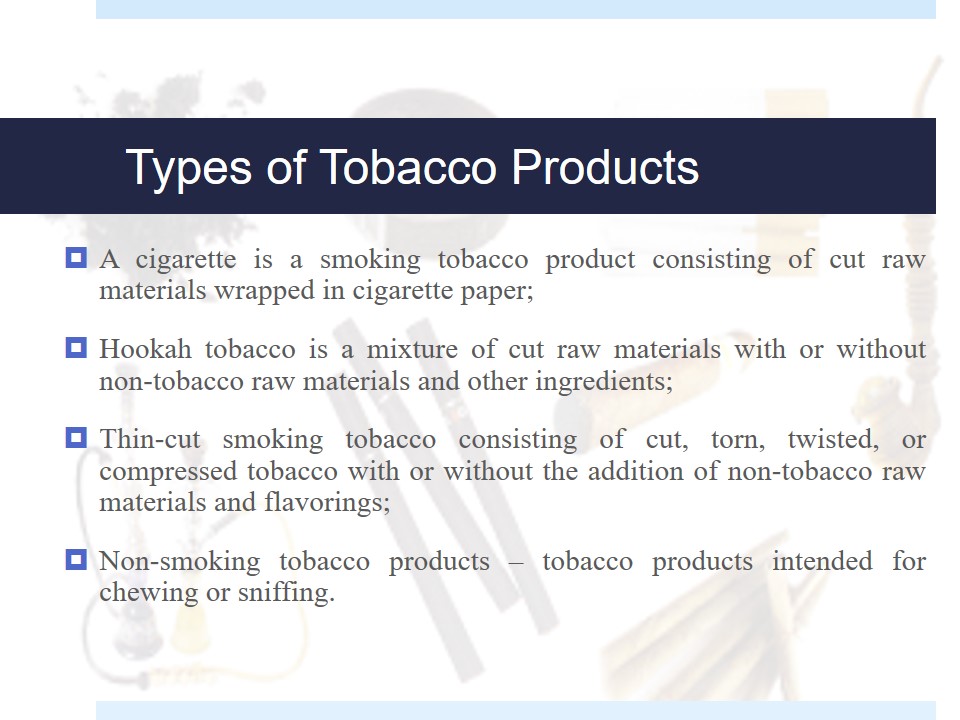
Clinical Manifestations
- Nicotine slightly increases a heart rate, blood pressure, and respiratory rate (Addiction Center 2021).
- When people first use nicotine, nausea often occurs.
- Nicotine reduces appetite and can be a behavioral substitute for eating (Addiction Center 2021).
- Smoking leads to yellow staining of teeth and fingers.
- Other symptoms include smoking-related lung and cardiovascular diseases (Addiction Center 2021).
Smokers may feel a surge of energy and excitement, an increase in the ability to concentrate, a decrease in the degree of tension, as well as a sense of satisfaction. Often there is a chronic cough and shortness of breath during exercise.
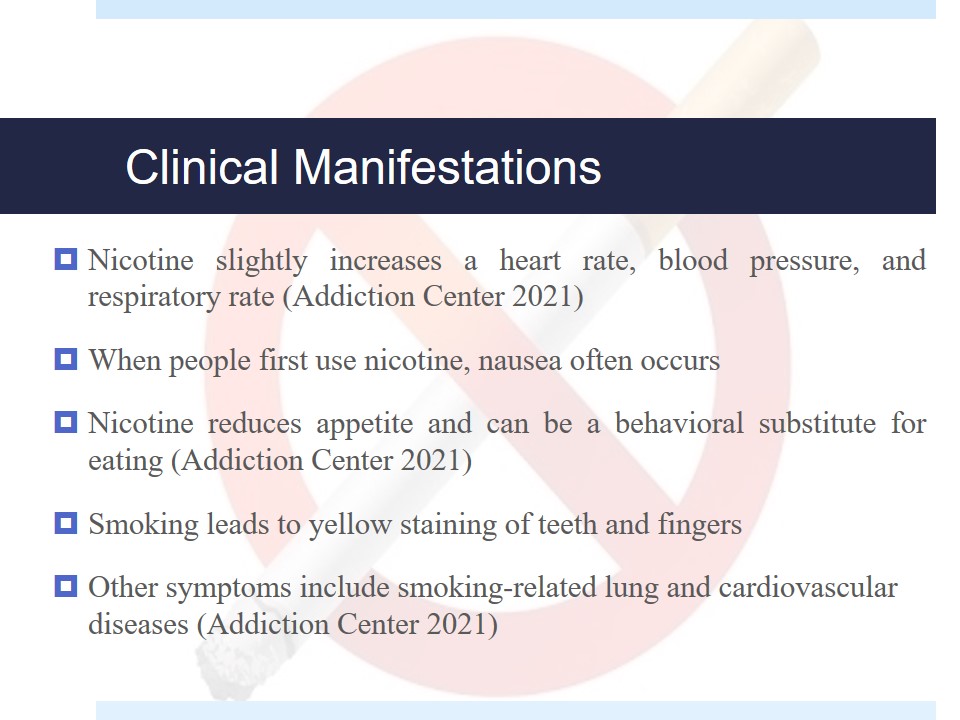
Why Do People Smoke?
- Lack of parental control.
- New “authorities”.
- Nervous overstrain.
Tobacco use is associated with many causes and at different ages. For example, in dysfunctional families where parents do not monitor the child, tobacco use can begin from early childhood. When attentive parents establish a ban on alcohol and tobacco in adolescence, young people may have other authorities. To follow them, they can start to lead an unhealthy lifestyle, including using tobacco in various forms. More adults use tobacco as a “cure” for stress. Unfortunately, none of the above people think about how much they spoil their bodies and even their appearance. In order to avoid premature death, people need to take care of their health by giving up the bad habit of smoking.
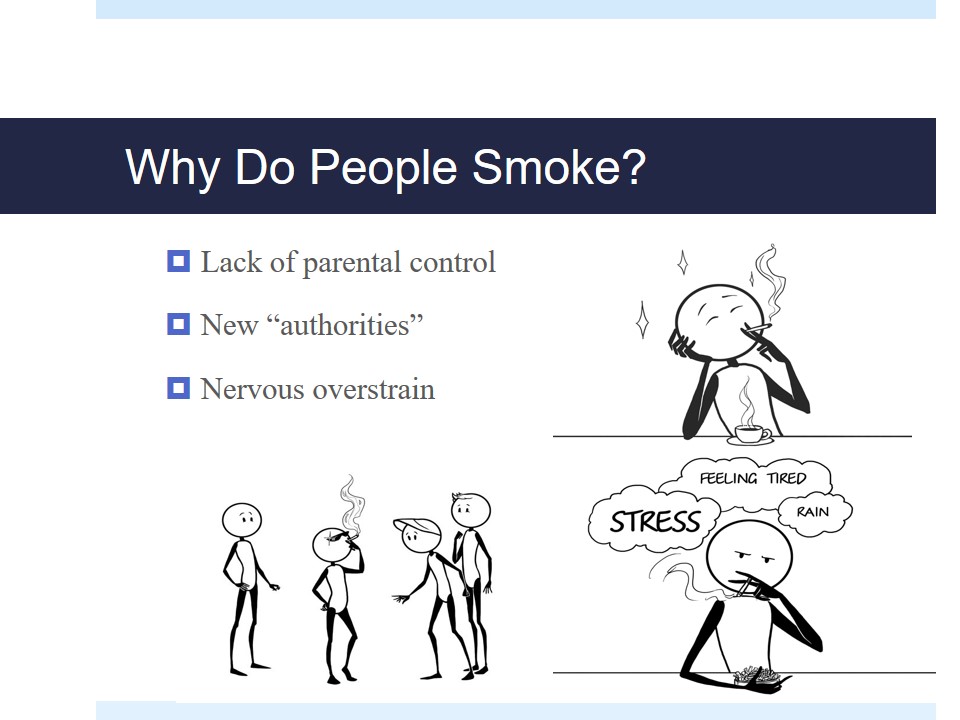
Statistics
- 8 million people die from tobacco use every year worldwide (WHO, 2020).
- In Mississippi, children breathe air polluted by tobacco smoke in public places, and 65,000 people die from second-hand smoke each year (WHO, 2020).
- Among Mississippi High School youth, 6.6% reported currently smoking cigarettes (CDC, 2021).
Tobacco is often equated with an epidemic as addiction engulfs an increasing number of people and spreads rapidly. According to the WHO (2020), about 8 million people die from tobacco use every year worldwide, of which 7 million are direct smokers, and 1 million are non-smokers and second-hand smokers. To narrow it down to a contracting state like Mississippi, children breathe air polluted by tobacco smoke in public places, and 65,000 people die from second-hand smoke each year (WHO 2020). Mississippi is a state with a low standard of living, partly why tobacco use is quite active here. Moreover, it is not possible to consult a specialist in such countries, and it is complicated for people to get rid of the habit on their own. Among Mississippi High School youth, 6.6% reported currently smoking cigarettes (CDC 2021). These statistics are shocking, but there are ways to prevent deaths and illnesses caused by tobacco use.

Health Promotion Plan
- The development of a sociogram of the problem of tobacco use.
- Summing up all the answers, it is necessary to determine which age group a person belongs to when they started using tobacco and assign it to previously formed groups based on the same characteristics.
- For each group, a list of actions will be formed to help them get rid of smoking.
- For example, people in Mississippi who became addicted to smoking should conduct a course of lectures with illustrative examples of the impact of tobacco smoking on appearance and health and the health of the future generation.
- Provide people with substitute products that will replace their smoking.
- Based on the data of the conducted tests, competent doctors will choose the necessary medications that will have a beneficial effect on getting rid of the smoking habit.
- Smoking cessation can be achieved by interacting with smokers, offering social and therapeutic help to quit smoking (Omare et al. 2020).
First, it is necessary to develop a sociogram of the problem of tobacco use. It includes studying the specific state in which a person lives, their marital status and family relationships, where they work, and what standard of living they consider themselves to be. Then, summing up all the answers, it is necessary to determine which age group a person belongs to when they started using tobacco and assign it to previously formed groups based on the same characteristics. Then, for each group, a list of actions will be formed to help them get rid of smoking. There will also be a list of rehabilitation procedures that will improve the health and condition of people. The basis is taken by the citizens of the state of Mississippi, and naturally, most of them will agree to undergo a survey and take part in a study to get help in getting rid of smoking. The rest of them will be less trusting about the research procedure, but somehow they will assess the benefits that this analysis can bring them. Groups formed by age and reasons for smoking will be offered a treatment and recovery plan. This division will help professionals choose the most suitable programs for groups of people with similar data.
It is necessary to think carefully about the course of teaching lectures on the dangers of smoking, and it should clearly identify the goals (Flanders 2018). In addition, can be offered them a list of activities that will help them get rid of thoughts about smoking. These can be certain sports or entertainment. Several medications can help people get rid of the smoking habit. Counseling and drug therapy are effective individually for the treatment of nicotine addiction, but in combination, their effectiveness increases. Evison et al. (2020) recommended to assess the need for additional medications, such as varenicline and bupropion. Therefore, medical personnel should try to ensure that each patient receives both advisory and medical care. This will help professionals win over people who smoke on their own, and will give these people the understanding that these professionals can be trusted.
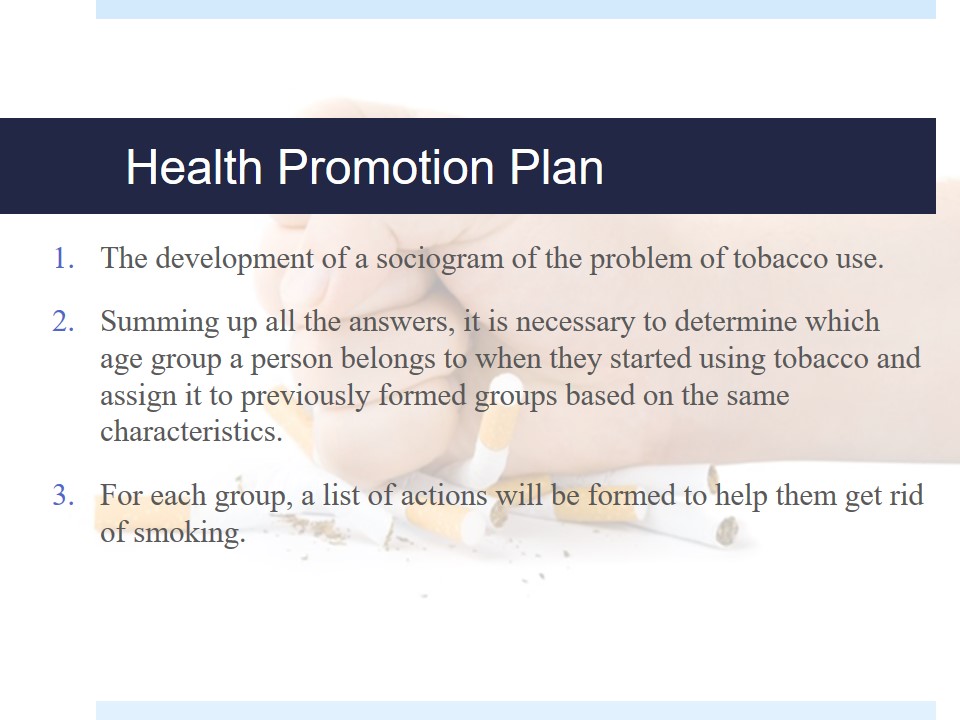

Expected Educational Session Outcomes
The expected outcomes of this type of treatment will be:
- a significant reduction in the number of smokers currently;
- a reduction in potential smokers in the future in a particular state.
Treatment of nicotine addiction and tobacco smoking is beneficial for the patient in reducing the risk of death and cost-effectiveness.
A clear division of people based on the test results, qualified doctors and medical staff, correctly formed proposals for treatment and recovery from addiction and smoking will bring positive results. In addition, it will help to influence the younger generation and show them how dangerous and harmful smoking can be.
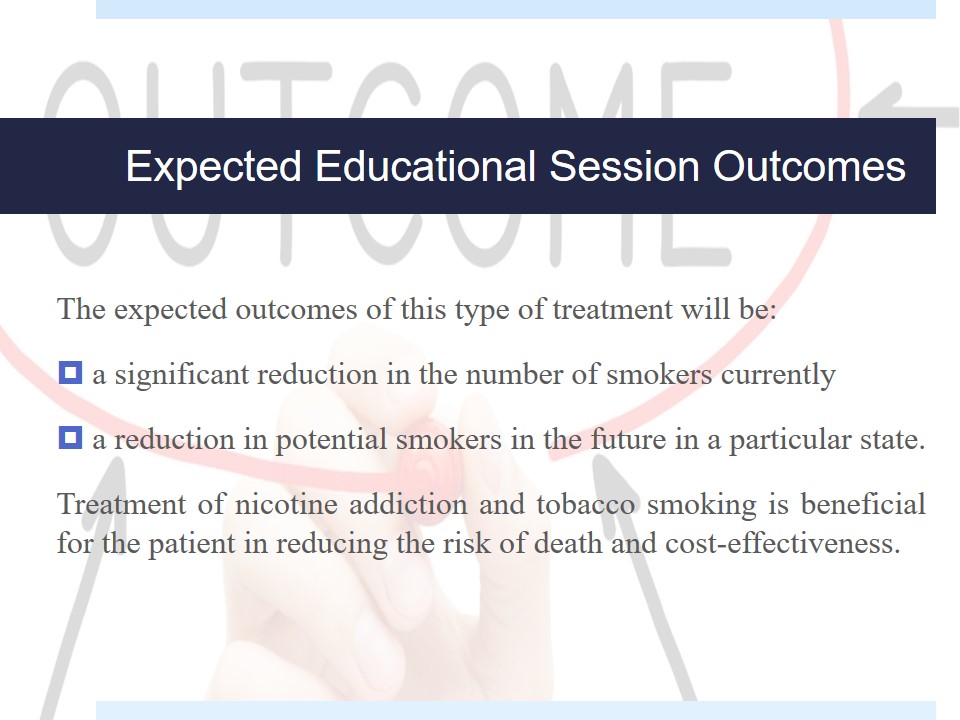
Healthy People 2030
- Healthy People 2030 aims to increase the number of people who quit smoking from 8.3% to 10.2% (Healthy people 2030 n.d.).
- The strategy developed in this project can help achieve such results, starting with the state of Mississippi.
Naturally, in addition to these strategies, others will be needed, which will be aimed at combating cigarette manufacturers. For example, increasing taxes for tobacco manufacturers so that the high price per unit of product is less affordable for the population and smoking. Moreover, the active promotion of the harm of smoking at public events can also play a role in helping people who need to stop smoking.

Achieved Goals
- Thanks to the developed strategy, the number of people who use tobacco has significantly decreased.
- After the session, a survey was conducted among young Mississippians about whether to spoil their health using tobacco products.
- Working with tobacco producers requires more time, but it will be successful in the future.
Most said they are not going to use tobacco. To improve the plan for getting rid of bad habits, it is necessary to invite lecturers from different States who will talk about the dangers of smoking and talk about how to act to lead a healthy lifestyle.
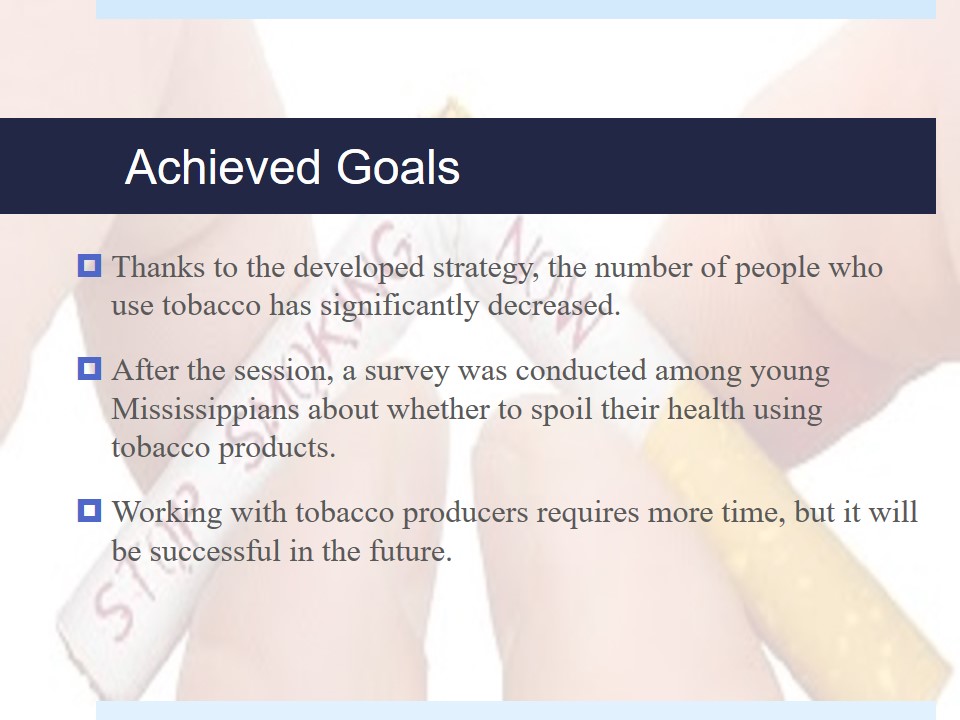
Conclusion
One of the most critical problems that harm the human body is smoking. The developed action plan to get rid of Mississippi citizens will positively impact their health and help them get rid of the bad habit of smoking.
People need to get rid of this addiction that can eventually lead to death.
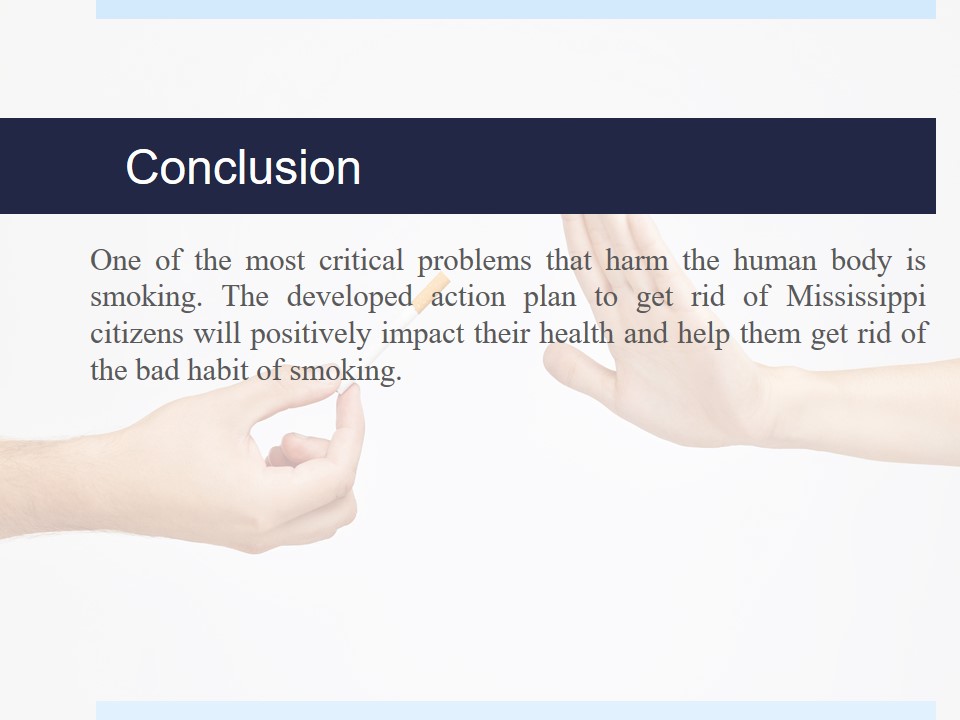
References
Addiction Center (2021). Recognizing nicotine addiction. Web.
American Cancer Society (2020). Harmful chemicals in tobacco products. Web.
Centers for Disease Control and Prevention. (2021). Extinguishing thetobacco epidemic in Mississippi. Cdc. Web.
Evison, M., Pearse, C., Howle, F., Baugh, M., Huddart, H., Ashton, E., Rutherford, M., Kearney, C., Elsey, L., Staniforth, D., Hoyle, K., Raja, M., Jerram, J., Regan, D., Booton, R., Britton, J., O’Rourke, C., Shackley, D., Benbow, L., Crossfield, A., Pilkington, J., Bailey, M. & Preece, R. (2020). Feasibility, uptake and impact of a hospital-wide tobacco addiction treatment pathway: Results from the cure project pilot. Clinical Medicine, 20(2), 196-202. Web.
Flanders, S. A. (2018). Effective patient education: Evidence and common sense. Medsurg Nursing, 27(1), 55–58.
Omare, M., Kibet, J., Cherutoi, J. & Kengara, F. (2020). A review of tobacco abuse and its epidemiological consequences. Journal of Public Health: From Theory to Practice. Web.
U.S. Department of Health and Human Services, Office of Disease Prevention and Health Promotion. (n.d.). Healthy People 2030. Web.
World Health Organization. (2020). Tobacco. WHO | World Health Organization. Web.